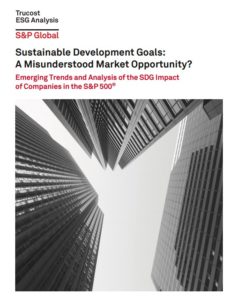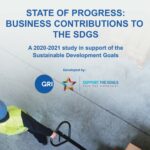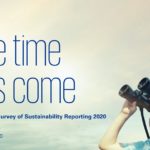
Trucost, part of S&P Global released a research report titled “Sustainable Development Goals (SDGs) – A Misunderstood Market Opportunity?” assessing the SDG impact of companies listed on the S&P 500®. The findings show that the SDGs reported by companies does not align with the goals that have the highest risk exposure to the organization. The analysis found that the SDGs with the highest level of exposure are issues related to financial secrecy (SDG 17), land pollution and deforestation (SDG 15), and water overconsumption and pollution (SDG 6). Yet, these topline SDGs differ significantly from the most common SDGs that are included and prioritized in the majority of company disclosures, including health (SDG 3), economic growth (SDG 8), sustainable consumption and production (SDG 12), and climate action (SDG 13).
“With our SDG analytics for financial portfolios we hope we can accelerate global progress towards achieving SDGs by helping investors to understand the positive impact of investment decisions alongside traditional considerations of risk and return,” said Dr. Richard Mattison, Chief Executive Officer, Trucost. “The United Nations SDGs provide critical context to help investors measure their progress on a globally relevant set of ESG considerations adopted by 178 countries.”
This research will be discussed at an upcoming event hosted by S&P Global, titled “Accelerating Progress on Climate Risk,” at the New York Stock Exchange on Monday, March 2, 2020. The event will explore key considerations around the collective action needed to tackle climate change.
Informing the research is Trucost’s latest dataset ‘SDG Analytics for Financial Portfolios,’ developed with the engagement from almost 250 participants to help investors evaluate portfolio SDG alignment and risk exposures. Trucost’s analytics provide 164+ positive impact categories aligned with the SDG Taxonomy and 45 SDG risk exposure metrics across 3,500 companies representing 85% of global market capitalization.
It has been four years since the UN adopted the 2030 Agenda for Sustainable Development introducing its 17 SDGs. These SDGs are a collection of 17 global goals designed to be a blueprint to achieve a better and more sustainable future.
Dr. Mattison added: “This research is a part of our continued commitment to accelerating progress towards a more sustainable future. We found that the majority of companies do not report on their progress against the SDGs and if they do there is an emphasis on only positive impacts. The launch of SDG Analytics means that market participants can now have balanced view on the progress that companies are making on SDGs in this decade of action.”



